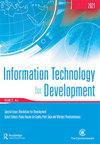Exploring the gender gap in mobile money awareness and use: evidence from eight low and middle income countries
IF 5.1
3区 管理学
Q1 DEVELOPMENT STUDIES
引用次数: 1
Abstract
ABSTRACT We used three waves of Financial Inclusion Insights surveys (2013–2016) to examine gender gaps in mobile money (MM) awareness and use across eight low- and middle-income countries. After accounting for socio-demographic factors (age, marriage, literacy, education, employment, income, and financial numeracy) and other enabling factors (mobile phone, formal identification, and bank account), we found no independent association between gender and MM use in established MM markets in Kenya, Tanzania, and Uganda. In contrast, in emerging MM markets (Bangladesh, India, Indonesia, Nigeria, and Pakistan), significant gender differences in MM use remained. Phone and bank account access had stronger associations with MM use for men than for women in these MM markets, and gender gaps in MM use increased over time. Findings suggest realizing the financial inclusion potential of MM may require a more nuanced understanding of difficult-to-measure and slow-to-change factors – such as legal and social norms – constraining women’s MM use.探索移动支付意识和使用方面的性别差距:来自八个低收入和中等收入国家的证据
我们使用了三波金融包容性洞察调查(2013-2016)来研究八个低收入和中等收入国家在移动货币(MM)意识和使用方面的性别差异。在考虑了社会人口因素(年龄、婚姻、识字、教育、就业、收入和财务计算能力)和其他使能因素(手机、正式身份证明和银行账户)之后,我们发现在肯尼亚、坦桑尼亚和乌干达的成熟MM市场中,性别和MM使用之间没有独立的关联。相比之下,在新兴的MM市场(孟加拉国、印度、印度尼西亚、尼日利亚和巴基斯坦),MM的使用仍然存在显著的性别差异。在这些MM市场中,电话和银行账户访问与男性MM使用的关联比女性更强,并且MM使用的性别差距随着时间的推移而增加。研究结果表明,要实现MM的普惠金融潜力,可能需要更细致地了解限制女性MM使用的难以衡量和变化缓慢的因素,如法律和社会规范。
本文章由计算机程序翻译,如有差异,请以英文原文为准。
求助全文
约1分钟内获得全文
求助全文
来源期刊

Information Technology for Development
Multiple-
CiteScore
11.30
自引率
16.70%
发文量
34
期刊介绍:
Information Technology for Development , with an established record for publishing quality research and influencing practice, is the first journal to have explicitly addressed global information technology issues and opportunities. It publishes social and technical research on the effects of Information Technology (IT) on economic, social and human development. The objective of the Journal is to provide a forum for policy-makers, practitioners, and academics to discuss strategies and best practices, tools and techniques for ascertaining the effects of IT infrastructures in government, civil societies and the private sector, and theories and frameworks that explain the effects of IT on development. The concept of development relates to social, economic and human outcomes from the implementation of Information and Communication Technology (ICT) tools, technologies, and infrastructures. In addition to being a valuable publication in the field of information systems, Information Technology for Development is also cited in fields such as public administration, economics, and international development and business, and has a particularly large readership in international agencies connected to the Commonwealth Secretariat, United Nations, and World Bank.
 求助内容:
求助内容: 应助结果提醒方式:
应助结果提醒方式:


